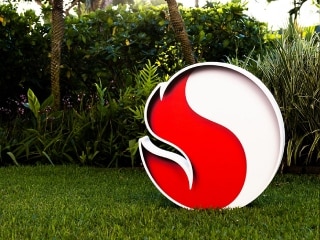- Home
- Science
- Science News
- Blue Origin Successfully Tests Escape System, Lands Rocket
Blue Origin Successfully Tests Escape System, Lands Rocket

Rocket company Blue Origin pulled off a double success Wednesday, coming a step closer to launching people into space.
The aerospace startup led by Amazon's Jeff Bezos tested the escape system of its space capsule in remote west Texas. Forty-five seconds into the flight, the capsule popped off like a champagne cork, propelled by an escape motor mounted underneath.
Not only did the empty capsule land safely under parachutes four minutes after liftoff, the rocket managed to fly back and land upright. This was the first inflight test of the emergency escape system, designed to save lives if something goes wrong with the rocket during liftoff, and the first test of its kind in the U.S. since the 1960s.
Blue Origin's launch commentators called it an "epic flight" from beginning to end. Bezos had warned in advance that the booster rocket probably would end up crashing back to Earth, after being jolted by the 70,000 pounds of force exerted by the escape system. Instead, the booster made what looked to be a fine vertical touchdown seven minutes after liftoff, just a couple miles from its launch pad.
"Wow. There it is. There you go, New Shepard. Look at her," launch commentator Ariane Cornell exclaimed once the booster landed. "What an extraordinary test and a tremendous final flight for both craft."
The rocket and capsule system are intended for suborbital flight and are called New Shepard after the first American in space, Alan Shepard. Bezos hopes to launch the first test flight with humans as early as next year, followed by tourists and other paying customers. The capsule could hold up to six people.
Blue Origin is aiming for reusability to lower launch costs. After the capsule darted away at 400 mph, the rocket kept going up, reaching more than 240,000 feet high, before descending to the desert floor.
This rocket has flown five times and is now bound for a museum along with the capsule. The capsule also had flown before, including a launch pad escape test, minus a rocket, in 2012.
Based in Kent, Washington, Blue Origin has taken over a launch pad at Cape Canaveral Air Force Station for future orbital flights. That newly unveiled system, still in development, is called New Glenn for the first American to orbit the Earth, John Glenn.
While another private space company, SpaceX, has landed some of its first-stage boosters at Cape Canaveral or just offshore on a floating platform — all of them used in orbital missions — it has yet to reuse any of these recovered rockets. It had hoped to do so by year's end, but an explosion on the launch pad during testing on September 1 has everything on hold. Both the SpaceX Falcon rocket and its payload, an Israeli satellite, were destroyed.
Blue Origin's escape system differs from that used by Nasa during the Mercury, Gemini and Apollo programs, and what the Russians still use on their Soyuz capsules. Those capsules were designed to be pulled off by an escape tower mounted on top, while the New Shepard vessel is meant to be pushed off from a motor underneath. That way, the escape motor can be flown multiple times, as long as it is not activated in an emergency. The escape towers, meanwhile, have to be jettisoned before re-entry.
The Soyuz system actually saved the lives of two Soviet cosmonauts in 1983 when their rocket caught fire on the pad.
Back in the 1960s, Nasa propelled mock Apollo spacecraft off Little Joe II rockets in preparation for the moon-landing missions, but no one was on board.
Blue Origin broadcast the test live on its website.
Catch the latest from the Consumer Electronics Show on Gadgets 360, at our CES 2026 hub.
Related Stories
- Samsung Galaxy Unpacked 2025
- ChatGPT
- Redmi Note 14 Pro+
- iPhone 16
- Apple Vision Pro
- Oneplus 12
- OnePlus Nord CE 3 Lite 5G
- iPhone 13
- Xiaomi 14 Pro
- Oppo Find N3
- Tecno Spark Go (2023)
- Realme V30
- Best Phones Under 25000
- Samsung Galaxy S24 Series
- Cryptocurrency
- iQoo 12
- Samsung Galaxy S24 Ultra
- Giottus
- Samsung Galaxy Z Flip 5
- Apple 'Scary Fast'
- Housefull 5
- GoPro Hero 12 Black Review
- Invincible Season 2
- JioGlass
- HD Ready TV
- Laptop Under 50000
- Smartwatch Under 10000
- Latest Mobile Phones
- Compare Phones
- OPPO A6 Pro 5G
- OPPO A6s
- OPPO Reno 15 Pro Max
- Honor Win RT
- Honor Win
- Xiaomi 17 Ultra Leica Edition
- Xiaomi 17 Ultra
- Huawei Nova 15
- Asus ProArt P16
- MacBook Pro 14-inch (M5, 2025)
- OPPO Pad Air 5
- Huawei MatePad 11.5 (2026)
- Xiaomi Watch 5
- Huawei Watch 10th Anniversary Edition
- Acerpure Nitro Z Series 100-inch QLED TV
- Samsung 43 Inch LED Ultra HD (4K) Smart TV (UA43UE81AFULXL)
- Asus ROG Ally
- Nintendo Switch Lite
- Haier 1.6 Ton 5 Star Inverter Split AC (HSU19G-MZAID5BN-INV)
- Haier 1.6 Ton 5 Star Inverter Split AC (HSU19G-MZAIM5BN-INV)
















